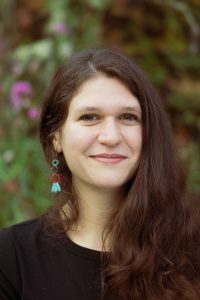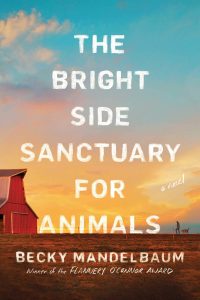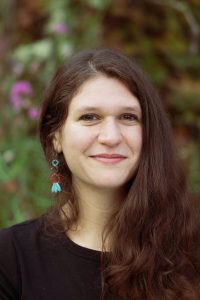Featured Author: Becky Mandelbaum
 In her first novel Becky Mandelbaum transports readers to an overwhelmed animal sanctuary in western Kansas. The Bright Side Sanctuary for Animals is a story about second chances, the bonds between animals and humans, and the way family impacts our lives. The action takes place in an area often considered flyover country. Mandelbaum is a Kansas native and her love for the state inspired her to write a novel that would paint a prettier picture and fly in the face of stereotypes. “I didn’t realize until I left that most people outside the state have a negative perception of Kansas,” Mandelbaum said. “I want people to see that Kansas is as complicated and beautiful as any other place. […] I also feel called to defend my home, to make others see her beauty the way I do.”
In her first novel Becky Mandelbaum transports readers to an overwhelmed animal sanctuary in western Kansas. The Bright Side Sanctuary for Animals is a story about second chances, the bonds between animals and humans, and the way family impacts our lives. The action takes place in an area often considered flyover country. Mandelbaum is a Kansas native and her love for the state inspired her to write a novel that would paint a prettier picture and fly in the face of stereotypes. “I didn’t realize until I left that most people outside the state have a negative perception of Kansas,” Mandelbaum said. “I want people to see that Kansas is as complicated and beautiful as any other place. […] I also feel called to defend my home, to make others see her beauty the way I do.” Focusing on Relationships
 The story opens in 2016 just after the presidential election. Tensions are high across Kansas and the nation. Mona runs an animal sanctuary with the help of one hired man, Gideon. Together they save many animals from abuse and death, but the work is intense and the bills are high. It looks like Mona may have to sell her land and give up the sanctuary, especially after a neighbor sets fire to her barn and vandalizes her property with hate speech. Mona’s daughter, Ariel, has lived in Lawrence since she ran away to attend college years before. She hasn’t been home or called her mother since she left. However, when Ariel hears about the fire, she knows she has to go home, help her mom and mend fences.
The story opens in 2016 just after the presidential election. Tensions are high across Kansas and the nation. Mona runs an animal sanctuary with the help of one hired man, Gideon. Together they save many animals from abuse and death, but the work is intense and the bills are high. It looks like Mona may have to sell her land and give up the sanctuary, especially after a neighbor sets fire to her barn and vandalizes her property with hate speech. Mona’s daughter, Ariel, has lived in Lawrence since she ran away to attend college years before. She hasn’t been home or called her mother since she left. However, when Ariel hears about the fire, she knows she has to go home, help her mom and mend fences. Breaking Stereotypes
The Bright Side Sanctuary for Animals seems like it could be very political or divisive, as it is set during an election year and was published just before another presidential election. Instead it’s a very human book. The big picture is framed around the election that has just concluded, then the story zooms in to how people live their everyday lives on the ground in our state. Mandelbaum seems to set us up with stereotypes and expectations for her characters, only to knock those presumptions sideways or out from under us with complex, flawed, lovable personalities. “I did want to give every character a fair shake,” Mandelbaum said. “Nobody, not even radical right-wing neo-Nazis, should be wholly defined by their worst qualities. I wrote this book because I was exhausted by the way social media flattens our sense of reality—we see what someone posts or tweets and we think: this is that entire person. We pull out one sentence or one action from a person’s life— their digital life— and explode it out to represent their entire personhood. I think this is extremely dangerous. […] I wanted this book to add some nuance and shades of gray into the narrative. Nobody is 100% evil and nobody is 100% good. Not on either side.”Exploring the Bond Between Humans and Animals
Mandelbaum was inspired by a real life animal sanctuary and wanted to show a bit of the grim reality such places face. She also wanted to explore the special bond humans have with animals, which is often more pure and less complicated than the relationships humans form with each other. “I spent the past few years taking care of other people’s animals—dogs and cats, mostly—and was always surprised by how immediately I fell in love,” Mandelbaum said. “The bond between people and animals is so special, because the relationship is entirely rooted in the physical world. It’s all about gestures, touch and body language. There are no words to get in the way. I can be myself around animals in a way I can’t around humans and take great comfort in spending times with animals because of this. I wanted to explore this ease in the book, how animals can comfort us and show us who we are when removed of language, judgment and pretense.” Read on for our full interview with Mandelbaum, then check out The Bright Side Sanctuary for Animals or Mandelbaum’s award-winning short story collection Bad Kansas.loading...
Full Interview with Becky Mandelbaum
I follow you on social media, so I know that you love dogs. Even if I hadn't known anything about you, though, I would have guessed that the author of this book holds a deep love and compassion for animals. What inspired you to write a book about a struggling animal sanctuary? Did you do any research or have a hands-on experience with the work of an animal sanctuary?
I started this book when I was an undergraduate at the University of Kansas. While there, I went on a few service learning trips with Alternative Breaks. We volunteered at the Austin Zoo, an exotic animal sanctuary, and a sanctuary for big cats (think: Tiger King). We also went to an animal sanctuary that was mostly dogs and cats. The owner was so dedicated to the animals, but she was clearly in over her head. There were hundreds of dogs and cats. Hundreds of feral hogs. Horses, sheep, chickens and ducks. Aside from volunteers, she only had one person helping her. Despite the chaos, she was so hardworking and determined—I was just fascinated by her. The first draft of this book was inspired by her and my time at that sanctuary. The current book is several big drafts removed from the initial manuscript, but the heart of the book is rooted in that sanctuary.How has your own experience with animals and pets informed the love and bond that is seen between animals and humans in your book?
I’ve lived with a lot of animals, most of them not my own. So I was eager to explore the way intense bonds can flourish quickly between humans and animals. I spent the past few years taking care of other people’s animals—dogs and cats, mostly—and was always surprised by how immediately I fell in love. The bond between people and animals is so special, because the relationship is entirely rooted in the physical world. It’s all about gestures, touch and body language. There are no words to get in the way. I can be myself around animals in a way I can’t around humans, and take great comfort in spending times with animals because of this. I wanted to explore this ease in the book, how animals can comfort us and show us who we are when removed of language, judgment and pretense.I appreciate that literature set in Kansas always includes plenty of scenery! The sky, space and prairie of Kansas are brought to life in your book. As a native of Kansas, how does the landscape inspire your writing? Is it easier to write about the state from a distance now that you live elsewhere?
I miss Kansas every day. Where I live now, in northwest Washington, has to be one of the most beautiful places in the county. But it’s easy to love mountains, lakes and the ocean. I think it takes a more skilled heart to love the prairie—like you said, the sky, the space, the absence of features and spectacles. Washington is the bedazzled prom queen and Kansas is the awkward girl in the corner who’s secretly brilliant and hilarious, and actually kind of hot once she lets her hair down. She’s humble and I love her so much for that. Another part of why I write about Kansas is to show others a more dynamic view of the Midwest. I didn’t realize, until I left, that most people outside the state have a negative perception of Kansas. I want people to see that Kansas is as complicated and beautiful as any other place. So maybe it’s not only easier to write about it from a distance—there’s a perspective I have now that I didn’t when I lived there—but that I also feel called to defend my home, to make others see her beauty the way I do.Your book starts out with a reference to the 2016 election, was recently released in an election year, and Ariel and Mona are both very clear about their left-leaning politics. However, you also present a complex character in Big John, a neighbor with a Trump sign in his yard who turns out to defy Ariel's expectations (and maybe the reader's, as well). All of the characters are presented as flawed, no matter their politics. How did you approach writing a story with a political charge, while also trying to avoid stereotypes? Did you plan this book release for an election year?
When I wrote this book, the last thing I imagined was that it would actually be published. I typically write in a vacuum—it’s just the page and me. So I was definitely not writing toward a political agenda, because I wasn’t writing toward anything. I set the book during the aftermath of the 2016 election because I was writing it during the months after the election, and it was everywhere. I just knew if I didn’t address the moment in some way, I wouldn’t stay interested enough in the story to finish it. The election, and what it signified for the country and said about us as a people, was all I could think about, so that context just inserted itself into the revision. I did want to give every character a fair shake. Nobody, not even radical right-wing neo-Nazis, should be wholly defined by their worst qualities. I wrote this book because I was exhausted by the way social media flattens our sense of reality—we see what someone posts or tweets and we think: this is that entire person. We pull out one sentence or one action from a person’s life— their digital life— and explode it out to represent their entire personhood. I think this is extremely dangerous. It’s also advantageous for people in power like Trump, who want us to think in black and white. It’s easier to hate someone when we see them in black and white, and hate is a tool that makes a population easy to control. We know, as readers and writers and people, that the world is not black and white. I wanted this book to add some nuance and shades of gray into the narrative. Nobody is 100% evil and nobody is 100% good. Not on either side.The Bright Side Sanctuary for Animals is your first novel, and you actually wrote the draft that would become this book several years ago. How did the novel change as you reworked it for publication? As a writer, how do you experience writing short stories differently than writing a novel?
Turns out writing a novel is much harder than writing stories. Maintaining narrative momentum, balancing the present moment with backstory, negotiating the passage of time, and simply remembering what happened on page 20 so you can accurately write back on page 220 are all a lot harder than managing a short story. Revising a novel is also exponentially harder. At one point in revision I introduced a new dog to the cast. That meant I had to go back and write the dog into every scene. The attention to detail is just insane. Novels are also much harder to control than stories. As a writer—and a human—it feels scary to be out of control. In this way, stories feel safer. A story is small enough that you can hold the whole thing in the palm of your hand. You can turn it and inspect it and chisel away at any imperfections. The novel is simply too big. It’s like trying to hold a mountain. No matter how hard you try, you just can’t see the whole thing at once. You can see a meadow, or a cliff-face, or a section of forest, but to get a sense of the whole thing, you just have to climb around, and it’s hard work. It’s easier to get lost, or grow exhausted, or just want to come down and stand on flat ground. But it’s also beautiful once you’re at the top, the whole thing beneath your feet. So the rewards are greater, but the journey there is, to say the least, rough.Dex became an outside perspective on Ariel and Mona that helped us see the story from another point of view. Why did you choose to look through Dex's eyes as opposed to another of the main characters, such as Gideon?
That the book is told from Ariel and Dex’s perspective is more of a fluke than an intentional craft decision. When I began this book back in college, it was more of a love story between Ariel and Dex. So their points of view earned space on the page. As I revised, the narrative shifted away from their love story and more toward the relationship between Ariel and Mona. At one point, someone suggested I include chapters from Mona’s point-of-view, and I’m so glad I did. But the book was already shaped by Ariel and Dex’s narratives.You left a lot of questions unresolved at the end of your novel! Did you make a deliberate choice to let readers come to some of their own conclusions? (Side note: I'm a fan of this, myself, as I often feel that tying everything up with a bow lessens the emotional impact in the final chapters or pages).
Yes! I wanted the ending to reflect our current moment (or really any moment), where we really don’t know what’s going to happen next, and we just have to trust that love will win out. I don’t want to spoil what happens, but I’ll just say that I also wanted the ending to be a feminist ending, meaning the emphasis wasn’t placed on Ariel’s romantic relationships, but on other relationships more foundational to her personhood. To me, the ending feels satisfying because I believe Ariel’s understanding of love and family have fundamentally shifted. That’s all I need to know to imagine what she’ll do next, in her other relationships, how she’ll apply the lessons she’s learned.*Becky Mandelbaum was interview by Miranda Ericsson via email in September, 2020.
Becky Mandelbaum is the author of The Bright Side Sanctuary for Animals and Bad Kansas which received the 2016 Flannery O’Connor Award for Short Fiction, the 2018 High Plains Book Award for First Book, and was a Kansas Notable Book in 2018. Her work has appeared in One Story, The Sun, The Missouri Review, The Georgia Review, Alaska Quarterly Review, The Rumpus, Necessary Fiction, Hobart, Prairie Schooner, Electric Literature, McSweeney’s Internet Tendency and has been featured on Medium. She received fellowships from Writing by Writers, a residency from The Helene Wurlitzer Foundation, and was a finalist for the 2019 Disquiet Literary Prize in Fiction. Originally from Kansas, she currently lives in Bellingham, Washington. Learn more about her work.











